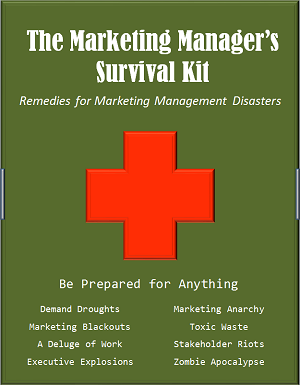Marketing management is a dangerous job. Stalled revenue, sudden budget cuts, and political finger pointing are constant threats to even the most talented marketing management professional. Marketing management disasters come in three general forms: natural environmental shocks, self-inflicted man-made crises, and socio-political unrest. To survive, you must be prepared.
In this not-so-tongue-and-cheek blog series, we present 18 Marketing Management Survival Tactics for staving off common marketing management disasters. The first post explored how to survive marketing management natural disasters. This second post in the series provides 6 proven tactics for avoiding common man-made marketing management accidents.
Marketing Blackouts

Light the Way with Complete Visibility
If no one knows what marketing is doing, then the natural conclusion is that marketing isn’t doing anything terribly important. Moreover, when different groups within the marketing organization don’t know what other groups are doing, it is impossible to provide a unified experience for your customers. Unfortunately, most marketing plans, projects and performance reports are hidden away in spreadsheets, documents, email inboxes and other poorly lit locations.
Ending a marketing blackout requires systematic collection, integration and publication of marketing plans, projects and performance. Current marketing plans, status of work-in-process and marketing performance reports for each marketing area should be available to everyone in the marketing department. High level roadmaps, monthly marketing calendars, and regular updates should be published to all marketing stakeholders. Without an integrated marketing management system, consolidating and communicating marketing activities is pure overhead and can be quite labor intensive. However, the alternative marketing blackout is far worse.
High level roadmaps, monthly marketing calendars, and regular updates should be published to all marketing stakeholders. Marketing calendars and roadmaps can also help you see if your marketing work is properly balanced, prioritized and integrated by highlighting critical strategic dimensions such as market segment, channel, product, buyer personae, and strategic initiative.
Publish a Marketing Calendar
Keep everyone informed about upcoming marketing promotions, projects, and events by sharing marketing plans throughout the company. Marketing calendars and roadmaps can also help you see if your marketing work is properly balanced, prioritized and integrated by highlighting critical strategic dimensions such as market segment, channel, product, buyer personae, and strategic initiative. The hard part is keeping it all up to date. The best practice is to use a marketing calendar that is tied directly to your marketing project management system, so everyone always has real-time information. Unfortunately, this lack of integration and visibility is a common project management software pitfall. If your systems are not integrated, task someone to update your marketing calendar no less than weekly, as others will come to rely on the information in the calendar, and you can’t afford to have it out of date.
Marketing Project Management
Real-time visibility across the entire marketing department requires detailed project tracking. Consider implementing a marketing project management system. A rigorous and automated approach to marketing project management increases the probability that reality mirrors your marketing plan, and eliminates busy work. If you systematically collect information at the project level, then higher-level views, such as marketing roadmaps, calendars and progress reports can be completely automated.
Executive Explosions
Defuse Volatile Situations
Sometimes big problems come in small, well-intentioned packages. For example, when the VP of Sales makes a simple and reasonable request that threatens to blow up all your well-thought-out marketing plans and committed marketing goals. Can we upgrade the website next month? Let’s start doing webinars once a week. And, so forth. Then there are the super urgent, yet conflicting requests. The VP of sales wants a website upgrade, but the VP of customer success wants a community portal, and, you only have one web team.
The ability to defuse potentially volatile situations involving hard-charging, single-minded executives is an essential marketing manager skill. Life is easier, however, if skill is also supported by process and a few facts. Executives ask marketing for things they think they need to be successful. However, exactly what they need and when they need it allows room for negotiation. What is the priority of the request relative to projects on the current marketing roadmap? Does it all need to be done yesterday, or can it be broken up into smaller projects and rolled out over time? Or frankly, is it sufficient to just capture the idea for future consideration.
Manage Scope, Not Just Resources
The secret deactivation code to defuse every explosive executive situation is the word “YES”. Manage project scope, not just resources. By breaking big project requests up into smaller increments, you can provide immediate satisfaction without derailing current marketing plans. Say “YES” to something small today, and deliver the bigger vision incrementally over time.
Public Marketing Backlog
An executive request that looks important and easy in isolation, might be foolish and difficult when weighed against current marketing plans. Everyone wants marketing to work on the most valuable ideas, so keep a prioritized backlog of all potential marketing projects and publish it for stakeholders to see. Build consensus around your marketing plan and backlog priorities. Now handling a new request is just an exercise in reordering the backlog.
Toxic Waste
Clean Up Rework and Useless Meetings
Most marketing departments are under-resourced and over-committed. There is no time for do-overs. Fuzzy objectives, fuzzy assignments, fuzzy agendas, fuzzy hand-offs and fuzzy communications lead to endless marketing rework and countless hours spent in useless staff meetings. Busy work that eats up precious marketing cycles without moving things forward is a toxic waste of time that can seriously undermine marketing performance.
Cleaning up waste from rework requires clearing up day-to-day marketing management activities. Luckily, it doesn’t require a lot of overhead. Rigorous work habits and simple process rules will often do the trick. Make sure strategic marketing goals are clear, so you don’t waste time on unimportant projects. Don’t start a new marketing project without clear objectives and requirements. Create modest project plans with a special focus on deliverable hand-offs to coordinate cross-functional teams. Make sure every project and deliverable has a single, clear owner. Bring an agenda to every meeting and record issues, decisions, and action items.
Marketing Collaboration
Email, chat, and social tools are great for one-off conversations, but they lack the context, depth and continuity required for purposeful collaboration. Consider a implementing a platform designed specifically for marketing team collaboration that links conversations, documents, and decisions directly to projects for greater efficiency and links projects to strategy for better marketing execution.
Management by Exception
Streamline team meetings by eliminating updates on work that is going according to plan—just make sure the plan is up-to-date before the meeting. Focus instead on coordinating hand-offs, resolving issues, helping stuck team members, and removing obstacles from blocked projects.
If you like these marketing management survival tactics, then check out the complete Marketing Manager’s Survival Kit and get all 18 tactics.



